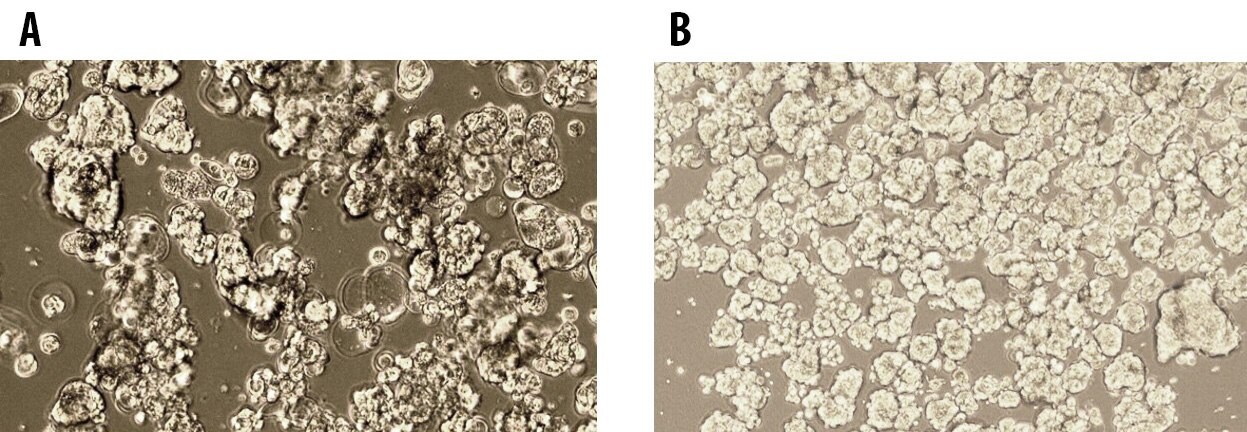Cancer Stem Cell Proliferation in Human Prostate and Breast Cancer Cell Lines Utilizing a New Defined Serum-Free 3D Spheroid Media
Solid tumors grow in a three-dimensional (3D) spatial conformation, resulting in a heterogeneous exposure to oxygen and nutrients as well as to other physical and chemical stresses. To mimic the 3D spatial conformation, 3D culture models have been used in cancer research since the diffusion-limited distribution of oxygen (hypoxia), nutrients, metabolites, and signaling molecules is not mimicked in conventional two-dimensional (2D) monolayer cultures. Cancer stem cell (CSCs) are defined as a small subset of cells within a tumor with the ability to self-renew and often drive tumor progression and recurrence after chemotherapy treatment. Traditionally, cancer stem cells have been isolated from cancer cell lines and tumor biopsies and grown in undefined serum containing media using 3D tumorsphere cultures. Here we report a new defined serum-free cancer stem cell media that supports the expansion of human prostate (E006AA) and breast (MCF-7) cancer cell lines using a 3D tumorsphere culture method. Both cells showed continuous proliferation supported during serial passage of 3D tumorsphere cultures. In addition to the stable proliferation, increased Aldehyde Dehydrogenase (ALDH) expressing cancer stem cell populations were observed after multiple passages in this new 3D cancer stem cell media.
Section Overview
Methods
Tumorsphere Formation and Expansion
- 40,000 cells (10,000 cells/mL) per well of E006AA Human Prostate Cancer Cell Line or MCF7 Cell Line human (86012803-1VL) were plated in triplicate in the new chemically defined cell culture Media, 3dGRO® Spheroid Medium (S3077) using Corning® Costar® Ultra-Low attachment multiwell plates (CLS3471).
- Serial passage by enzymatic dissociation with Trypsin-EDTA (T4049) was performed every 7 days for E006AA cells and every 9 days for MCF7 cells.
- Tumorsphere formation and proliferation were maintained during the culture, which was discontinued after passage 5 or 6.
- E006AA cells and MCF7 cells were also maintained in EmbryoMax® DMEM - High Glucose, Low Bicarbonate w/o Sodium Pyruvate (SLM-220-M) with 10% EmbryoMax® ES Cell Qualified Fetal Bovine Serum in adherent (2D) culture as controls.
- After the passages of 1, 3, and 5 the proliferations were measured with MTT Cell Growth Assay Kit (CT01) and Aldehyde Dehydrogenase (ALDH) Expression was analyzed by flow cytometry with AldeRed ALDH Detection Assay (SCR150)
Cancer Stem Cell Identification
Cancer stem cell express elevated levels of Aldehyde Dehydrogenase (ALDH). AldeRed™ ALDH Detection Assay enables live cancer stem cell identification and isolation based on ALDH expression using a red-shifted fluorescent substrate for ALDH, allowing concurrent use of green fluorescent reporters including GFP cell lines.
- Dry AldeRed 588-A reagent was resuspended in DMSO and activated by addition of 2N HCl.
- Each cell sample was suspended in the Assay Buffer and AldeRed 588-A reagent was added.
- Immediately, the sample was split between two tubes, one of which contained DEAB, an inhibitor of ALDH. Reactions were carried at 37 ºC for 30 min followed by a round of wash in Assay Buffer.
- Detection of AldeRed 588-A was carried on cytometry instruments equipped with blue and/or green laser with PE and/or PE-TexasRed detectors (Guava, Muse, ACEA Novocyte, Beckman).
Results
- Tumorsphere formation and proliferation were maintained during the culture of both MCF7 and E006AA cells in 3dGRO® Spheroid Medium. (Figure 1, 2, 3)
- E006AA cells attached to the plates at the first passage (Figure 3A) and the cells didn’t proliferate well until the 2nd passage however at the 3rd passage the proliferation took off (Figure 1) and the cells started to form tumorsphere formation (Figure 3B) in 3dGRO® Spheroid Medium.
- In 3dGRO® Spheroid Medium the proliferation of MCF7 and E006AA were maintained around 50 to 90 % (MCF7) and 140 to 180 % (E006AA) of proliferation compare to the standard DMEM 2D culture at the all three passages.
- At the passage 3 and 5 ALDHHigh stem cell population of MCF7 cells was increased to around 8 % in 3dGRO® Spheroid Medium compared to less than 4% of normal (adherent) cultured cells. (Figure 4A)
- At passage 1, 3, and 5 ALDHHigh stem cell population of E006AA cells was increased to 7-13 % in 3dGRO® Spheroid Medium compared to less than 4% of normal (adherent) cultured cells. The ALDHHigh populations of E006AA cells were increased in 3dGRO® Spheroid Medium at higher passages. (Figure 4B)

Figure 1.Stable Growth of Cancer Cells in 3dGRO® Spheroid Medium. Cumulative population doublings of MCF7 cells and E006AA cells during serial passage of 3D tumorsphere cultures was plotted.

Figure 2.Tumorsphere formation of MCF7 Breast Cancer Cells at Passage 1 (A) and Passage 5 (B) cultured in 3dGRO® Spheroid Medium.

Figure 3.Tumorsphere formation of E006AA Prostate Cancer Cells at Passage 1 (A) and Passage 5 (B) cultured in 3dGRO® Spheroid Medium.

Figure 4.An enrichment of ALDHhigh cancer stem cell populations occurs when cancer cells are grown in 3dGRO® Spheroid Medium after 5 passages in 3D tumorsphere cultures.
Conclusions
- Tumorsphere formation and proliferation were maintained during the culture of both MCF7 cells and E006AA cells in 3dGRO® Spheroid Medium.
- With increased serial passaging, both MCF7 cells and E006AA cells form more sphere structures at higher passage numbers. The morphology change was more dramatic with E006AA cells.
- Increase of ALDHHigh stem cell population was observed with both MCF7 cells and E006AA cells maintained in 3dGRO® Spheroid Medium. The increase was more dramatic in E006AA cells.
Related Products
To continue reading please sign in or create an account.
Don't Have An Account?